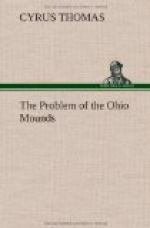Although varied indefinitely by the addition of animal and other figures, the typical or simple form of the pipe of the Ohio mound-builders appears to have been that represented by Squier and Davis [Footnote: Ancient Monuments of the Mississippi Valley, 1847, p. 179.] in their Fig. 68; and by Rau in Smithsonian Contributions to Knowledge, No. 287. [Footnote: 1876, p. 47, Fig. 177.] The peculiar feature is the broad, flat, and slightly-curved base or stem, which projects beyond the bowl to an extent usually equal to the perforated end. Reference has already been made to the statement by Adair that the Cherokees were accustomed to carve, from the soft stone found in the country, “pipes, full a span long, with the fore part commonly running out with a short peak two or three fingers broad and a quarter of an inch thick.” But he adds further, as if intending to describe the typical form of the Ohio pipe, “on both sides of the bowl lengthwise.” This addition is important, as it has been asserted [Footnote: Young Mineralogist and Antiquarian, 1885, No. 10. p. 79.] that no mention can be found of the manufacture or use of pipes of this form by the Indians, or that they had any knowledge of this form.
E. A. Barber says: [Footnote: Am. Nat., vol. 16, 1882, pp. 265, 266]
The earliest stone pipes from the mounds were always carved from a single piece, and consist of a flat curved base, of variable length and width, with the bowl rising from the center of the convex side (Anc. Mon., p. 227).
The typical mound pipe is the Monitor form, as it may be termed, possessing a short, cylindrical urn, or spool-shaped bowl, rising from the center of a flat and slightly-curved base. [Footnote: For examples of this form see Rau: Smithsonian Contributions to Knowledge, No. 287, p. 47, Fig. 177.]
Accepting this statement as proof that the “Monitor” pipe is generally understood to be the oldest type of the mound-builders’ pipe, it is easy to trace the modifications which brought into use the simple form of the modern Indian pipe. For example, there is one of the form shown in Fig. 5, from Hamilton County, Ohio; another from a large mound in Kanawha Valley, West Virginia; [Footnote: Science. 1884, vol. 3, p. 619.] several taken from Indian graves in Essex County, Mass.; [Footnote: Abbott, Prim. Industry, 1881, Fig. 313, p. 319; Bull. Essex Inst., vol. 3, 1872, p. 123.] another found in the grave of a Seneca Indian in the valley of the Genesee; [Footnote: Morgan, League of the Iroquois, p. 356.] and others found by the representatives of the Bureau of Ethnology in the mounds of western North Carolina.
[Illustration with caption: Fig. 5. Pipe from Hamilton County, Ohio.]




